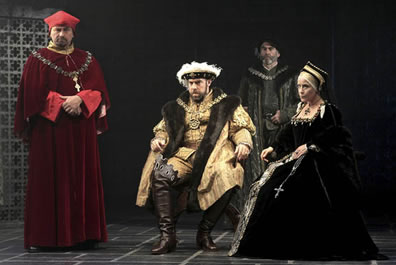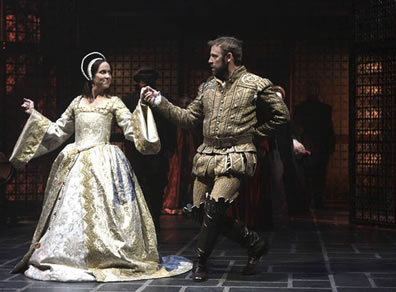Henry VIII
Dubious Pomp; Notorious Circumstances
Folger Theatre, Washington, D.C.
Thursday, November 4, 2010, F –8&10 (center stalls)
Directed by Robert Richmond
This was a milestone moment for me. Upon seeing this production, I have now seen performed live all 38 plays in Shakespeare’s official canon. Nevertheless, I approached this moment with some trepidation. This was, after all, Henry VIII. Having never seen it performed, I only knew the play from what’s on the page, and what’s on the page is a real snoozer.

From left, Wolsey (Anthony Cochrane), King Henry VIII (Ian Merrill Peakes), Duke of Norfolk (Lawrence Redmond), and Katherine (Naomi Jacobson) in Henry VIII at the Folger Theatre. Below, Henry dances with Anne Boleyn (Karen Peakes). Photo by Carol Pratt, Folger Shakespeare Library.
It is a reminder that even the greatest geniuses should know when to retire (or avoid collaboration, as Shakespeare wrote this with John Fletcher). Shakespeare may have written this only to pay tribute to Queen Elizabeth, though she was a decade dead. To get to that tribute at play’s end, we must muddle through a series of historical plotlines clumsily carried out by interchangeable characters giving too-long speeches and a titular figure with multiple archetype personalities: loving king in one scene, partying king in another scene, wise king in this scene, gulled king in that scene, angry king, nervous king, worried king—the only common thread being that he is a king. But even Shakespeare at his worst can’t be all bad, and Henry VIII has Katherine’s trial and Wolsey’s downfall, two scenes that rise to the level of Shakespearean greatness.
My trepidation was misplaced. After all, this was the Folger, where I have seen a gripping performance of Two Gentlemen of Verona and a Romeo & Juliet played with realism and urgency. Besides, we had come to regard just walking into the theater the makings of a great evening no matter what happened on the stage, thanks to transportative sets the designers consistently create at the Folger.
 And this set was the most stunning of all. Tony Cisek created what can best be described as a palatial dungeon: metal latticework walls for a backdrop coming in at angles from the wings and a matching thrust balcony above. These walls were beautiful, but they also looked like prison grates in the dim light. A single chair as throne sat on the middle of the stage, the only prop. Light struggled to pass through the latticework on the stage and also pierced through fog onto audience members settling into their seats. Lighting for the entire play, designed by Klyph Stanford, was without a doubt among the most emotionally charged I’ve seen for any production outside a U2 concert. The original compositions of Anthony Cochrane, who also played Wolsey, completed the mood for this court of intrigue. This court’s public persona might be jeweled majesty (kudos to costume designer William Ivey Long who met the challenge of presenting a Tudor court in the theater while contemporary portrayals of that same court were being exhibited in the next room), but within these claustrophobic power corridors, plots and gossip rippled through the dark air like danger.
And this set was the most stunning of all. Tony Cisek created what can best be described as a palatial dungeon: metal latticework walls for a backdrop coming in at angles from the wings and a matching thrust balcony above. These walls were beautiful, but they also looked like prison grates in the dim light. A single chair as throne sat on the middle of the stage, the only prop. Light struggled to pass through the latticework on the stage and also pierced through fog onto audience members settling into their seats. Lighting for the entire play, designed by Klyph Stanford, was without a doubt among the most emotionally charged I’ve seen for any production outside a U2 concert. The original compositions of Anthony Cochrane, who also played Wolsey, completed the mood for this court of intrigue. This court’s public persona might be jeweled majesty (kudos to costume designer William Ivey Long who met the challenge of presenting a Tudor court in the theater while contemporary portrayals of that same court were being exhibited in the next room), but within these claustrophobic power corridors, plots and gossip rippled through the dark air like danger.
Director Robert Richmond made two key logistic decisions in his staging of this play. One was that he made significant cuts in the text. How much? “A lot,” said the dramaturg and actors in the after-show talkback, each one elongating the word lot in emphasis to provide an aural measure, like saying a rottweiler is a big dog compared to a pug. Whatever and how much the cuts, the meandering plots seemed more concise, and the action moved along at a palatable clip. Richmond also used a cast of 11 for this play with 42 named roles (which doesn’t count the countless pages, spirits, lords, ladies, and gentlemen). The same group of actors playing the many interchangeable courtiers thematically illustrated that in politics most players rise and fall to various degrees but are essentially the same faceless souls (this idea was played literally in one scene where the gossips remained obscured behind the latticed walls as they spoke).
The stand-out characters other than the king are Queen Katharine and Cardinal Wolsey. The former liked to refer to herself as a weak woman, but Naomi Jacobson’s demeanor as she powerfully defended herself and demanded her rights as queen and wife made it obvious why Henry needed to go so far as to cause one of history’s significant social upheavals in order to get her out of his way. Cochrane—he who wrote the soundtrack to this production—fittingly spoke Cardinal Wolsey’s verse in studied musicality, a beautiful lyrical style that served to display both the character's superior intelligence, enabling him to smoothly maneuver through his scams, and his heartfelt conversion to grace after his downfall. It takes a skillful actor to ride the emotional roller coaster of the downfall scene, and Cochrane, in precisely rendered body language and eloquent verse, made it a thrilling ride.
While combining many characters, Richmond added two characters. One was Will Sommers, Henry’s jester, who opened this production with a puppet show preview of the action and then, starting with the part of Prologue, proceeded to narrate the play for the audience. He also filled in for several parts, such as the soldier come to arrest Buckingham and the Old Lady come to inform the king of Elizabeth’s birth. This interpolation may be anathema to purists, but it didn’t detract from the play’s action or purpose (for anybody who can actually identify the play’s action and purpose), and as played by Louis Butelli, the part provided some necessary and appropriate comic relief. The other new character was Mary, Henry’s eldest daughter (identified in the program as “Lady of the Court”). She spoke no lines though she did sing monastic-like snatches, but in her facial expressions and posture Megan Steigerwald revealed the neglected child who would, historically, come back to haunt England into near destruction.
There is a palpable disconnect between the history we know so well and the play Shakespeare wrote, and Richmond mined this disconnect to dramatic effect for the audience. We couldn’t help watching Karen Peakes’ Anne Boleyn protest she doesn’t want to be a queen even as we knew that within a few years she would lose her head. The disappointment (if not anger) Henry displayed at his second daughter’s birth played to an audience who knew that daughter, as Cranmer prophesied to a slightly ameliorated king, would become one of the greatest political leaders of all time. And we couldn’t watch this king careen from policymaking to partying and from court intrigue to courting women without knowing him to be one of England’s most notorious despots.
Ian Merrill Peakes hewed more closely to the historical Henry in his portrayal than he did to Shakespeare’s characterization. As Peakes said in the post-show discussion, Shakespeare didn’t give him much guidance in how to play the character. So, the actor fleshed out the part by studying biographies and drawing on previous non-Shakespearean portrayals of the king, including that of the Showtime soap opera The Tudors. Peakes’ Henry was a frat boy who took his role as ruler of a people seriously even as he toyed with his courtiers to the point of death, a king who wanted a lasting legacy for his beloved England but held a good party in equal esteem.
At play’s end, Will Sommers entertained the isolated king with a Henry puppet, then placed the puppet in King Henry’s lap. As the lights went down, king and puppet stared vacantly out toward the audience, the puppet requiring someone else’s manipulation to give him expression, the king bewildered by the manipulations of his own making that placed him there.
Eric Minton
November 6, 2010
Comment: e-mail editorial@shakespeareances.com
Start a discussion in the Bardroom



 Find additional Shakespeareances
Find additional Shakespeareances